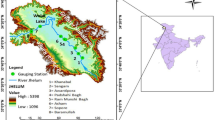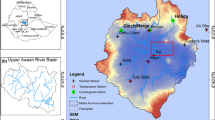Abstract
The Burhi Gandak River in north Bihar (India) affects agricultural land, industrial areas, commercial areas, and populations nearby riverbank. Therefore, the study focused on identifying areas exposed to hydrological risks and creating management plans for emergencies. The flood map makes it easy to spot flood-affected areas near the river. For analyzing flood inundation of the study area, discharge data of 50 years (1956–2005) for Sikandarpur gauge station are analyzed, and the same is forecasted for 5, 10, 20, 50, 100, 150-years return period. For flood frequency analysis, well-known probability distributions including generalized Pareto, generalized extreme value (GEV), log normal, Gumbel, and Weibull (1) were tested to calculate extreme flows for different return periods. The Kolmogorov–Smirnov test indicates the Gumbel distribution to be the most appropriate probability distribution for the study. To precisely identify and draw the flood inundation map, the HEC-RAS that models the river flow hydraulics used for the study area together with an extension of ArcGIS is known as HEC-GeoRAS. The main objective of the study is to define HEC-RAS model to find two flow variables (water depth and flow velocity).
Access this chapter
Tax calculation will be finalised at checkout
Purchases are for personal use only
Similar content being viewed by others
References
Apel H, Thieken AH, Merz B, Bloschl G (2006) A probabilistic modelling system for assessing flood risks. Nat Hazards 38(1):79–100. https://doi.org/10.1007/s11069-005-8603-7
Apel H, Merz B, Thieken AH (2008) Quantification of uncertainties in flood risk assessments. Int J River Basin Manage 6(2):149–162. https://doi.org/10.1080/15715124.2008.9635344
Awu JI, Mbajiorgu CC, Manta HI, James DD (2017) Flood inundation simulation using HEC-RAS hydrologic model: a case study of Oyun river, Nigeria. Int J Basic Appl Sci 7(1):62–68
Chang LF, Lin CH, Su MD (2008) Application of geographic weighted regression to establish flood-damage functions reflecting spatial variation. Water SA 34(2):209–216. https://doi.org/10.4314/wsa.v34i2.183641
Chow VT (1959) Open channel hydraulics, p 680. McGraw-Hill, New York
de Moel H, Aerts JCJH (2011) Effect of uncertainty in land use, damage models and inundation depth on flood damage estimates. Nat Hazards 58(1):407–425. https://doi.org/10.1007/s11069-010-9675-6
Hajibayov F, Ozkul BD, Terzi F (2017) Floodplain modeling and mapping using the geographical information systems (GIS) and Hec-RAS/Hec-GeoRAS applications: case of Edirne, Turkey. Geographical information science research-UK (GISRUK). The University of Manchester Ukraine
Ibrahim NF, Zardari NH, Shirazi SM, Mohd Haniffah MR, Mat Talib S, Yusop Z, Mohd Yusoff SMA (2017) Identification of vulnerable areas to floods in Kelantan river sub-basins by using flood vulnerability index. Int J GEOMATE 12(29):107–114
İcaga Y, Tas E, Kilit M (2016) Flood inundation mapping by GIS and a hydraulic model (HEC RAS): a case study of Akarcay Bolvadin subbasin, in Turkey. Acta Geobalcanica 2(2):111–118. https://doi.org/10.18509/AGB.2016.12
Khattak MS, Anwar F, Saeed TU, Sharif M, Sheraz K, Ahmed A (2016) Floodplain mapping using HEC-RAS and ArcGIS: a case study of Kabul river. Arab J Sci Eng 41(4):1375–1390. https://doi.org/10.1007/s13369-015-1915-3
Manjusree P, Bhatt CM, Begum A, Rao GS, Bhanumurthy V (2015) A decadal historical satellite data analysis for flood hazard evaluation: a case study of Bihar (North India). Singap J Trop Geogr 36(3):308–323. https://doi.org/10.1111/sjtg.12126
McGrath H, Stefanakis E, Nastev M (2015) Sensitivity analysis of flood damage estimates: a case study in Fredericton, New Brunswick. Int J Disaster Risk Reduction 14:379–387. https://doi.org/10.1016/j.ijdrr.2015.09.003
Merwade V, Cook A, Coonrod J (2008) GIS techniques for creating river terrain models for hydrodynamic modeling and flood inundation mapping. Environ Model Softw 23(10–11):1300–1311. https://doi.org/10.1016/j.envsoft.2008.03.005
Meyer V, Messner F (2005) National flood damage evaluation methods: a review of applied methods in England, the Netherlands, the Czech Republik and Germany, UFZ discussion papers 13/2005. http://hdl.handle.net/10419/45193
Mujiburrehman K (2015) Preparation of flood inundation map in Ganga river at Farakka bridge, Malda, West Bengal India. Int J Res Geogr 1(1):1–17
Nelson SA (2009) Flood hazards, prediction and human intervention. Nat Disasters EENS 3050
Porter J, Demeritt D (2012) Flood-risk management, mapping, and planning: the institutional politics of decision support in England. Environ Plan A 44(10):2359–2378. https://doi.org/10.1068/a44660
Sahu RT, Verma MK, Ahmad I (2021a) Segmental variability of precipitation in the Mahanadi river basin during 1901–2017. 24 August 2021, PREPRINT (Version 1) available at Research Square. https://doi.org/10.21203/rs.3.rs-542786/v1
Sahu RT, Verma MK, Ahmad I (2021b) Regional frequency analysis using L-moment methodology—a review. In: Pathak KK, Bandara JMSJ, Agrawal R (eds) Recent trends in civil engineering, Lecture notes in civil engineering, vol 77, pp 811–832. Springer, Singapore. https://doi.org/10.1007/978-981-15-5195-6_60
Sahu RT, Verma MK, Ahmad I (2021) Some non-uniformity patterns spread over the lower Mahanadi river basin India. Geocarto Int. https://doi.org/10.1080/10106049.2021.2005699
Sahu RT, Verma MK, Ahmad I (2021d) Characterization of precipitation in the subdivisions of the Mahanadi river basin, India. Acta Sci Agric 5(12):50–61. https://doi.org/10.31080/ASAG.2021.05.1085
USACE (2010) HEC-RAS, user manual, US Army Corps of Engineers (USACE), Hydrological Engineering Center, Davis, California
Verma S, Prasad AD, Verma MK (2021) Trend analysis and rainfall variability of monthly rainfall in Sheonath river basin, Chhattisgarh. In: Pathak KK, Bandara JMSJ, Agrawal R (eds) Recent trends in civil engineering, Lecture notes in civil engineering, vol 77, pp 770–790. Springer, Singapore. https://doi.org/10.1007/978-981-15-5195-6_58
Ward PJ, Moel HD, Aerts JCJH (2011) How are flood risk estimates affected by the choice of return-periods? Nat Hazard 11(12):3181–3195. https://doi.org/10.5194/nhess-11-3181-2011
Acknowledgements
The authors are grateful to NIT Raipur, WRD—Bihar, and all others who are directly or indirectly associated.
Author information
Authors and Affiliations
Corresponding author
Editor information
Editors and Affiliations
Ethics declarations
Conflict of Interest
All authors have provided their consent to submit this manuscript, and there is no conflict of interest between the authors.
Rights and permissions
Copyright information
© 2022 The Author(s), under exclusive license to Springer Nature Singapore Pte Ltd.
About this paper
Cite this paper
Pradhan, D., Sahu, R.T., Verma, M.K. (2022). Flood Inundation Mapping Using GIS and Hydraulic Model (HEC-RAS): A Case Study of the Burhi Gandak River, Bihar, India. In: Kumar, R., Ahn, C.W., Sharma, T.K., Verma, O.P., Agarwal, A. (eds) Soft Computing: Theories and Applications. Lecture Notes in Networks and Systems, vol 425. Springer, Singapore. https://doi.org/10.1007/978-981-19-0707-4_14
Download citation
DOI: https://doi.org/10.1007/978-981-19-0707-4_14
Published:
Publisher Name: Springer, Singapore
Print ISBN: 978-981-19-0706-7
Online ISBN: 978-981-19-0707-4
eBook Packages: Intelligent Technologies and RoboticsIntelligent Technologies and Robotics (R0)




